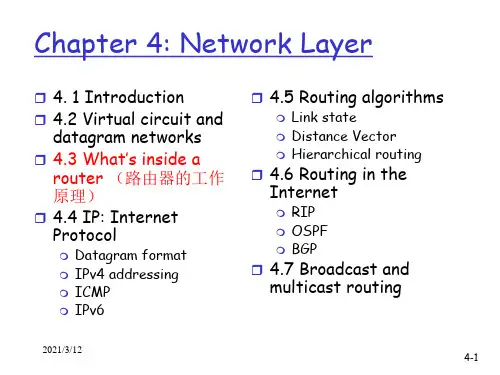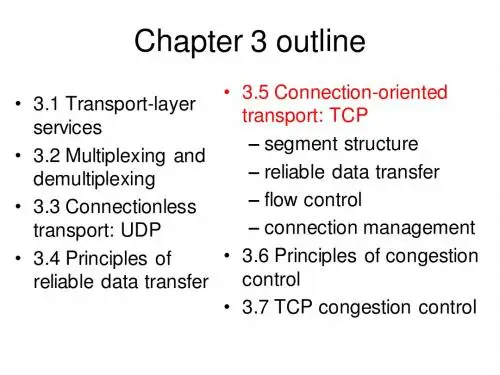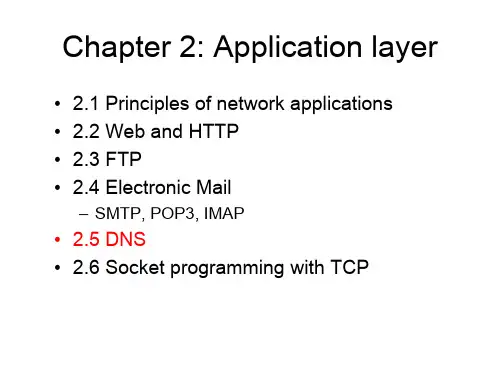- 1、下载文档前请自行甄别文档内容的完整性,平台不提供额外的编辑、内容补充、找答案等附加服务。
- 2、"仅部分预览"的文档,不可在线预览部分如存在完整性等问题,可反馈申请退款(可完整预览的文档不适用该条件!)。
- 3、如文档侵犯您的权益,请联系客服反馈,我们会尽快为您处理(人工客服工作时间:9:00-18:30)。
Wireless, Mobile Networks 6-3
Wireless
6.2 Wireless links, characteristics
CDMA
6.3 IEEE 802.11 wireless LANs (“Wi-Fi”) 6.4 Cellular Internet Access
architecture standards (e.g., GSM)
Elements of a wireless network
network infrastructure
Wireless, Mobile Networks
6-4
Elements of a wireless network
wireless hosts
network infrastructure
Wireless, Mobile Networks
6-6
Elements of a wireless network
wireless link
network infrastructure
typically used to connect mobile(s) to base station also used as backbone link multiple access protocol coordinates link access various data rates, transmission distance
base station
network infrastructure
typically connected to wired network relay - responsible for sending packets between wired network and wireless host(s) in its “area” e.g., cell towers, 802.11 access points
Wireless Link Characteristics (1)
important differences from wired link ….
decreased signal strength: radio signal attenuates as it propagates through matter (path loss) interference from other sources: standardized wireless network frequencies (e.g., 2.4 GHz) shared by other devices (e.g., phone); devices (motors) interfere as well multipath propagation: radio signal reflects off objects ground, arriving ad destination at slightly different times …. make communication across (even a point to point) wireless link much more “difficult” Wireless, Mobile Networks 6-13
laptop, smartphone run applications may be stationary (nonmobile) or mobile
wireless does not always mean mobility
Wireless, Mobile Networks
6-5
Elements of a wireless network
Wireless, Mobile Networks 6-12
Wireless
6.2 Wireless links, characteristics
CDMA
6.3 IEEE 802.11 wireless LANs (“Wi-Fi”) 6.4 Cellular Internet Access
architecture standards (e.g., GSM)
802.15
2.5G: UMTS/WCDMA, CDMA2000 2G: IS-95, CDMA, GSM
Indoor
10-30m
Outdoor
50-200m
Mid-range outdoor
200m – 4 Km
Long-range outdoor
5Km – 20 Km
Wireless, Mobile Networks 6-8
Elements of a wireless network
infrastructure mode
network infrastructure
base station connects mobiles into wired network handoff: mobile changes base station providing connection into wired network
Wireless, Mobile istics of selected wireless links
200 Data rate (Mbps)
802.11n
54
5-11 4 1 .384 .056
802.11a,g
802.11b
802.11a,g point-to-point 4G: LTWE WIMAX 3G: UMTS/WCDMA-HSPDA, CDMA2000-1xEVDO
Mobility
6.5 Principles: addressing and routing to mobile users 6.6 Mobile IP 6.7 Handling mobility in cellular networks 6.8 Mobility and higher-layer protocols 6.9 Summary
multiple hops
host may have to relay through several wireless nodes to connect to larger Internet: mesh net no base station, no connection to larger Internet. May have to relay to reach other a given wireless node MANET, VANET
Wireless, Mobile Networks
6-9
Elements of a wireless network
ad hoc mode no base stations nodes can only transmit to other nodes within link coverage nodes organize themselves into a network: route among themselves
Wireless, Mobile Networks 6-10
Wireless network taxonomy
single hop
infrastructure (e.g., APs)
host connects to base station (WiFi, WiMAX, cellular) which connects to larger Internet
Computer Networking: A Top Down Approach
6th edition Jim Kurose, Keith Ross Addison-Wesley March 2012
Ch. 6: Wireless and Mobile Networks
Background:
# wireless (mobile) phone subscribers now exceeds # wired phone subscribers (5-to-1)! # wireless Internet-connected devices equals # wireline Internet-connected devices
laptops, Internet-enabled phones promise anytime untethered Internet access
two important (but different) challenges
wireless: communication over wireless link mobility: handling the mobile user who changes point of attachment to network
Wireless, Mobile Networks
6-2
Chapter 6 outline
6.1 Introduction
Mobility
6.5 Principles: addressing and routing to mobile users 6.6 Mobile IP 6.7 Handling mobility in cellular networks 6.8 Mobility and higher-layer protocols 6.9 Summary
Chapter 6 Wireless and Mobile Networks
A note on the use of these ppt slides:
We’re making these slides freely available to all (faculty, students, readers). They’re in PowerPoint form so you see the animations; and can add, modify, and delete slides (including this one) and slide content to suit your needs. They obviously represent a lot of work on our part. In return for use, we only ask the following: If you use these slides (e.g., in a class) that you mention their source (after all, we’d like people to use our book!) If you post any slides on a www site, that you note that they are adapted from (or perhaps identical to) our slides, and note our copyright of this material. Thanks and enjoy! JFK/KWR All material copyright 1996-2012 J.F Kurose and K.W. Ross, All Rights Reserved Wireless, Mobile Networks 6-1










